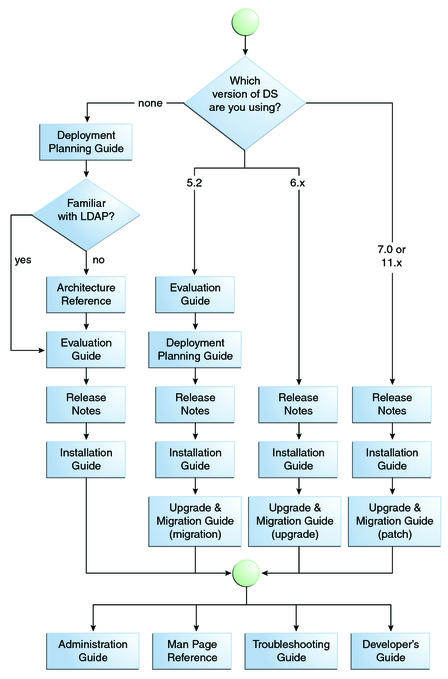| Skip Navigation Links | |
| Exit Print View | |

|
Oracle Directory Server Enterprise Edition Deployment Planning Guide 11g Release 1 (11.1.1.5.0) |
| Skip Navigation Links | |
| Exit Print View | |

|
Oracle Directory Server Enterprise Edition Deployment Planning Guide 11g Release 1 (11.1.1.5.0) |
Part I Overview of Deployment Planning for Directory Server Enterprise Edition
1. Introduction to Deployment Planning for Directory Server Enterprise Edition
2. Business Analysis for Directory Server Enterprise Edition
Part II Technical Requirements
3. Usage Analysis for Directory Server Enterprise Edition
4. Defining Data Characteristics
5. Defining Service Level Agreements
6. Tuning System Characteristics and Hardware Sizing
7. Identifying Security Requirements
8. Identifying Administration and Monitoring Requirements
9. Designing a Basic Deployment
10. Designing a Scaled Deployment
11. Designing a Global Deployment
12. Designing a Highly Available Deployment
Part IV Advanced Deployment Topics
13. Using LDAP-Based Naming With Solaris
14. Deploying a Virtual Directory
The Oracle Fusion Middleware Deployment Planning Guide for Oracle Directory Server Enterprise Edition 11g Release 1 (11.1.1.5.0) contains the information that you need to plan a directory service deployment. This guide describes the initial decisions that you need to make on issues such as data types, access control, and sizing. It also provides high-level examples and strategies that you can use for the specific requirements of your enterprise.
This guide is primarily intended for deployment architects and business planners responsible for the analysis and design of directory service deployments. This guide is also useful for system integrators and other people responsible for the design and implementation of enterprise applications.
This guide assumes that you are familiar with the basic concepts of LDAP directory servers and that you have read these documents:
This guide is based on a solution life cycle that describes the various phases of deployment planning.
Part I provides an introduction to Directory Server Enterprise Edition and explains the steps involved in planning a deployment (solution life cycle).
Part II describes the technical requirements analysis that must be performed before you can begin drawing up a logical deployment architecture. Technical requirements analysis requires an understanding of the business domain, business objectives, and the underlying system technology.
Part III describes how to create logical architectures for Directory Server Enterprise Edition deployments. It also provides sample logical architectures based on typical Directory Server Enterprise Edition deployment scenarios.
Part IV discusses specialized deployment topics including the use of LDAP-based naming services on the Solaris Operating System, Identity Synchronization for Windows, and the deployment of a virtual directory.
This documentation set explains how to use Oracle Directory Server Enterprise Edition to evaluate, design, deploy, and administer directory services. In addition, it shows how to develop client applications for Directory Server Enterprise Edition. The Directory Server Enterprise Edition documentation set is available at http://download.oracle.com/docs/cd/E20295_01/index.htm.
The following table lists the documents that make up the Directory Server Enterprise Edition documentation set.
Table P-1 Directory Server Enterprise Edition Documentation
|
For an introduction to Directory Server Enterprise Edition, review the following documents in the order in which they are listed.
Figure P-1 ODSEE Documentation Map

The SLAMD Distributed Load Generation Engine is a Java application that is designed to stress test and analyze the performance of network-based applications. This application was originally developed by Sun Microsystems, Inc. to benchmark and analyze the performance of LDAP directory servers. SLAMD is available as an open source application under the Sun Public License, an OSI-approved open source license. To obtain information about SLAMD, go to http://www.slamd.com/. SLAMD is also available as a java.net project. See https://slamd.dev.java.net/.
Java Naming and Directory Interface (JNDI) supports accessing the Directory Server using LDAP and DSML v2 from Java applications. For information about JNDI, see http://www.oracle.com/technetwork/java/jndi/index.html. The JNDI Tutorial contains detailed descriptions and examples of how to use JNDI. This tutorial is at http://download.oracle.com/javase/jndi/tutorial/.
Identity Synchronization for Windows uses Message Queue with a restricted license. Message Queue documentation is available at http://www.oracle.com/technetwork/indexes/documentation/index.html.
Identity Synchronization for Windows works with Microsoft Windows password policies.
Information about password policies for Windows 2003, is available in the Microsoft documentation online.
Information about the Microsoft Certificate Services Enterprise Root certificate authority, is available in the Microsoft support documentation online.
Information about configuring LDAP over SSL on Microsoft systems, is available in the Microsoft support documentation online.
Directory Server Enterprise Edition does not provide any files that you can redistribute.
This section explains the default paths used in documentation, and provides locations of commands on different operating systems and deployment types.
The table in this section describes the default paths that are used in this document. For complete descriptions of the files installed, see Chapter 1, Directory Server Enterprise Edition File Reference, in Oracle Directory Server Enterprise Edition Reference.
Table P-2 Default Paths
|
The table in this section provides locations for commands that are used in Directory Server Enterprise Edition documentation. To learn more about each of the commands, see the relevant man pages.
Table P-3 Command Locations
|
The following table describes the typographic conventions that are used in this book.
Table P-4 Typographic Conventions
|
The following table shows the default UNIX system prompt and superuser prompt for shells that are included in the Oracle Solaris OS. Note that the default system prompt that is displayed in command examples varies, depending on the Oracle Solaris release.
Table P-5 Shell Prompts
|
The following table explains symbols that might be used in this book.
Table P-6 Symbol Conventions
|
See the following web sites for additional resources:
Training – Click the Sun link in the left navigation bar.
Oracle Technology Network offers a range of resources related to Oracle software:
Discuss technical problems and solutions on the ODSEE Discussion Forum and the Directory Services blog.
Get hands-on step-by-step tutorials with Oracle By Example.
Download ODSEE 11g Example Files.